Crane for heating radiator: ball, cone devices, mayevsky's
If you are planning to start repairing pipes or batteries on your own, then it is imperative to understand which taps to put on radiators. The presence of a properly selected and efficiently functioning stop valves allows not only to disconnect heating devices for repair and maintenance, but also to regulate the amount of coolant entering the batteries.
In our article we will talk about which cranes can be mounted, and also describe their key features.
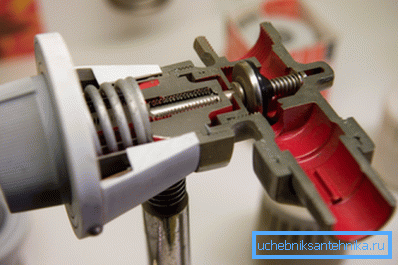
Locking devices
Ball
Cranes used for installation in a room heating system should be divided into two groups - shut-off and control. This division is largely arbitrary, since the shut-off valves also allow you to adjust the movement of the coolant. Naturally, in this case, the adjustment accuracy is quite low, but it is possible to cut off the battery from the water source.
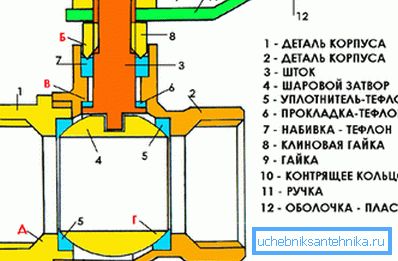
The simplest and most frequently used variety of cranes are ball:
- Ball valve is designed to turn off the radiator. Its design allows the device to be installed either in the open or in the closed position, so that the adjustment is carried out quite according to the principle “there is heat - there is no heat”.

Note! In principle, the valve can also be fixed in an intermediate position, but then its wear rate will increase many times due to friction of particles suspended in water against the locking element. So it is better not to do this without extreme necessity.
- Blocking the flow of coolant is carried out due to the movement of a metal ball with a hole coaxially with a pipe clearance. When you turn the handle of the crane in action comes the rod, which turns the sphere inside the body, combining the hole in it with the lumen of the pipe.
- As a rule, crane parts are made from steel, bronze or brass. Fluoroplastic gaskets are responsible for sealing joints and shut-off parts, which, if necessary, can be replaced with your own hands.
- Accession to the radiator is carried out either with a conventional nut, or with the help of "American."

Conical
Unlike ball valves, cone valves make it possible to regulate the flow of coolant more smoothly. This is provided by the features of their design:
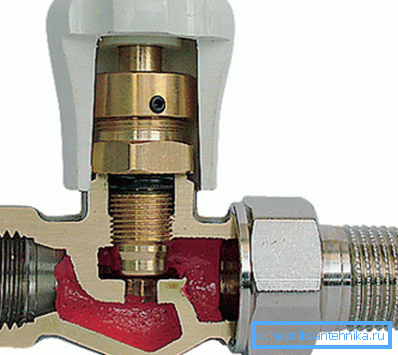
- The locking element is a tapered rod, on the surface of which the thread is applied.
- When we rotate the flywheel, the rod moves along the thread, moving in the vertical plane.
- In the lowest position, the lumen of the pipe completely overlaps. The tightness of the overlap is provided by elastic pads that are put on the annular grooves of the stem.
- Lifting the locking part, we open the lumen, and the coolant begins to flow into the radiator.
Note! Adjusting the indoor climate can only be approximately, reducing or increasing the amount of hot water in each battery.
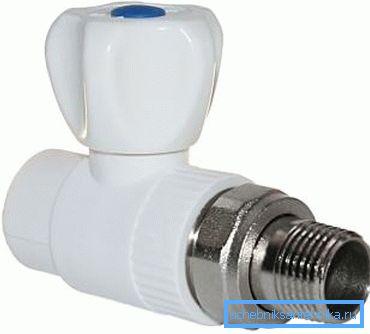
In practice, bronze or brass cone taps for heating radiators are most often used: only systems are completed with polypropylene, some of the pipes in which are also made of plastic. This is due to the relatively low strength and wear resistance of polymers compared with plumbing alloys.
On the other hand, polypropylene taps for radiators cost a little less, therefore, in conditions of budget deficit, they can be used.
Mayevsky's crane
When the coolant is poured into the heating system, air enters inside with water or antifreeze.
To remove it, use special devices - the so-called Mayevsky taps:
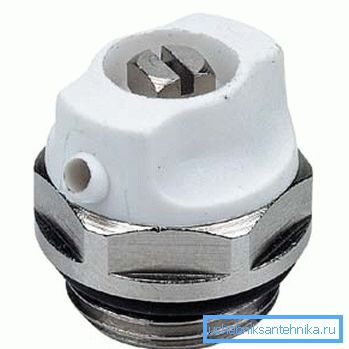
- The design of such a product is quite simple: it is based on a locking rod installed in a housing threaded with a radiator plug.
- The rod is set in motion either with a screwdriver or with a special key, opening the lumen of the pipe in the saddle.
Note! If possible, buy valves for a screwdriver, because you will lose the key regularly, which is not surprising - they will have to use it once or twice a year.
- It should be borne in mind that the capacity of such a crane is small, so, for example, you should not put it on the expansion tank: you will need to drain off the excess air for about an hour. In such a situation, a conventional valve or a water valve with a spout upwards is more suitable.
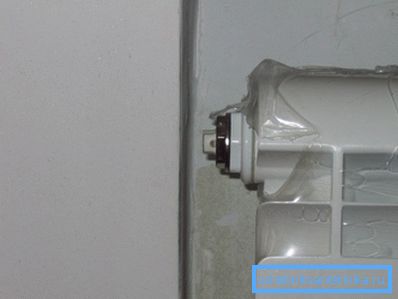
Control valves
Operating principle
The adjusting tap on the heating radiator is a device that allows you to automatically control the movement of the coolant.
The design of such products is quite complicated, but they also work much more efficiently than valves for manual adjustment:
- For the perception of the outside temperature meets the bellows - a container filled with liquid or gas. As the temperature rises, the bellows expands, affecting the regulator assembly.

Note! The price of liquid and gas-filled devices is about the same, but the features of work are different. So, gas models react faster to changes in temperature, and liquid models more accurately convey the effect on the coolant flow.
- The expanded bellows presses against the valve stem, which falls and gradually closes the valve saddle through which hot water enters the battery.
- When cooled, the opposite situation is observed: the stem rises, and the lumen of the saddle expands.
The degree of initial compression of the bellows we set ourselves, either by setting the desired temperature value on the digital display, or by rotating the mechanical adjustment knob. It is also possible to connect the thermal valve with external sensors - in this case, the rod movement is not controlled by the bellows, but by the servo drive under the action of an electrical or hydraulic system.
Installation of thermostatic valve
Among specialists, the question of whether it is necessary to install taps on radiators is practically not discussed. Even the installation of a simple ball valve provides a number of advantages, and the availability of high-quality thermostat - and even more so. However, the instruction advises when installing such devices to follow a number of rules:
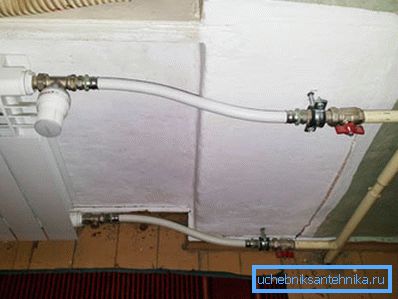
- First, you need to choose a suitable modification of the valve. For single pipe systems, we use products like RTD-G, for two-pipe - RTD-N.
- Secondly, before putting the taps on radiators, we check the direction of the coolant movement (indicated by the arrow on the body). If we confuse, then the device will work as you like, just not the way we need it.
- Third, we place the thermostatic head perpendicular to the plane of the battery so that the heat flow does not affect its operation.
How to regulate radiators with cranes is also a rather simple question:
- Having installed the valve on the radiator, we check the tightness and feed the coolant into the system.
- Using the handle or the dial, set the average temperature..
- After about an hour we adjust the valve setting according to your feelings and checking with the thermometer in the room.
- If necessary, repeat the adjustment again., however, this is usually not required.

After that, it is usually necessary to interfere with the operation of the device no more than once a month - with sudden changes in the external temperature.
Conclusion
It is impossible to say which cranes for radiators are better. Sometimes it is enough to embed an ordinary ball valve into the system, and sometimes to ensure a comfortable microclimate on each radiator it is necessary to install a thermostatic valve that regulates the temperature in automatic mode.
You can learn more about the types of fittings used and its use in arranging the heating system if you carefully review the video in this article.